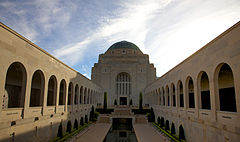Australian War Memorial
| Australian War Memorial | |
|---|---|
| Government of Australia | |
 |
|
| For Australian military dead of all wars | |
| Unveiled | 1941 |
| Location |
35°16′50″S 149°08′57″E / 35.2805°S 149.1491°ECoordinates: 35°16′50″S 149°08′57″E / 35.2805°S 149.1491°E Treloar Crescent Campbell, Australian Capital Territory, Australia |
| Designed by | Emil Sodersten and John Crust |
| Unknown burials | 1 |
The Australian War Memorial is Australia's national memorial to the members of its armed forces and supporting organisations who have died or participated in wars involving the Commonwealth of Australia. The memorial includes an extensive national military museum. The Australian War Memorial was opened in 1941, and is widely regarded as one of the most significant memorials of its type in the world.
The Memorial is located in Australia's capital, Canberra. It is the north terminus of the city's ceremonial land axis, which stretches from Parliament House on Capital Hill along a line passing through the summit of the cone-shaped Mount Ainslie to the northeast. No continuous roadway links the two points, but there is a clear line of sight from the front balcony of Parliament House to the War Memorial, and from the front steps of the War Memorial back to Parliament House.
The Australian War Memorial consists of three parts: the Commemorative Area (shrine) including the Hall of Memory with the Tomb of the Unknown Australian Soldier, the Memorial's galleries (museum) and Research Centre (records). The Memorial also has an outdoor Sculpture Garden. The Memorial is currently[update] open daily from 10am until 5pm, except on Christmas Day.
Many people include Anzac Parade as part of the Australian War Memorial because of the Parade's physical design leading up to the War Memorial, but it is maintained separately by the National Capital Authority (NCA).
Charles Bean, Australia's official World War I historian, first conceived a museum memorial to Australian soldiers while observing the 1916 battles in France. The Australian War Records Section was established in May 1917 to ensure preservation of records relating to the war being fought at the time. Records and relics were exhibited first in Melbourne and later Canberra.
...
Wikipedia
